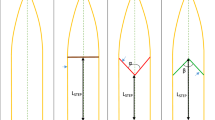Abstract
The inception of porpoising is theoretically predicted for planing vessels. Two different approaches are presented. First, a linear stability analysis is applied to find the porpoising limits while the hydrodynamic coefficients, i.e. added mass and damping coefficients, are determined by either a simplified method or a numerical method. Another approach is to seek the porpoising limits by performing nonlinear time domain simulations. Either the simplified method or the numerical method is used in the simulations. In the numerical method, a 2D+t theory together with a boundary element method is employed. The trim angle limits for porpoising are determined by changing the longitudinal position of the centre of gravity (COG) of the vessel and keeping the forward speed constant. The predicted porpoising limits are compared with Day and Haag’s (Planing boat porpoising, Thesis, Webb Institute of Naval Architecture, 1952) experimental results. The influences of parameters such as the load coefficient, the vertical position of COG and the radius of gyration of the ship are investigated by varying those parameters in the linear stability analysis. In the nonlinear time-domain simulations, by trying different longitudinal position of COG, one can find the critical trim angle when the porpoising commences. The obtained trim limits agree generally with those predicted by the linear stability analysis. Bounded oscillations for the unstable cases near the critical trim angle can be seen in the time-domain simulations due to the nonlinear effects.















Similar content being viewed by others
References
Day JP, Haag RJ (1952) Planing boat porpoising. Thesis, Webb Institute of Naval Architecture
Savitsky D (1964) Hydrodynamic design of planing hulls. Mar Technol 1:71–95
Celano T (1998) The prediction of porpoising inception for modern planing craft. SNAME Trans 106:269–292
Troesch AW (1992) On the hydrodynamics of vertically oscillating planing hulls. J Ship Res 36:317–331
Troesch AW, Falzarano JM (1993) Modern nonlinear dynamical analysis of vertical plane motion of planing hulls. J Ship Res 37:189–199
Martin M (1978) Theoretical determination of porpoising instability of high-speed planing boats. J Ship Res 22:32–53
Ikeda Y, Katayama T (2000) Porpoising oscillations of very-high-speed marine craft. Philos Trans R Soc Lond A 358:1905–1915
Salvesen N, Tuck EO, Faltinsen OM (1970) Ship motions and sea loads. Trans SNAME 78:250–287
Fujino M, Chiu FC (1983) Vertical motions of high-speed boats in head sea and wave loads. J Soc Nav Arch Jpn 154:151–162
Chiu FC, Fujino M (1989) Nonlinear prediction of vertical motions and wave loads of high-speed crafts in head sea. Int Shipbuild Prog 36:193–232
Katayama T, Hinami T, Ikeda Y (2000) Longitudinal motion of super high-speed planing craft in regular head waves. In: 4th Osaka colloquium on seakeeping performance of ships, 2000, pp 214–220
Garme K, Rosén A (2003) Time-domain simulations and full-scale trials on planing craft in waves. Int Shipbuild Prog 50:177–208
Caponnetto M, Söding H, Azcueta R (2003) Motion simulation for planing boats in waves. Ship Technol Res 50:182–198
Katayama T, Taniguchi T, Habara K (2010) Tank tests to estimate onset of dynamic instabilities of high-speed planing craft. In: Proceedings of the 2nd Chesapeake power boat symposium, St. Johns College, Annapolis, Maryland, USA
Faltinsen OM (2005) Hydrodynamics of high-speed marine vehicles. Cambridge University Press, New York
Zhao R, Faltinsen OM, Haslum HA (1997) A simplified nonlinear analysis of a high-speed planing craft in calm water. In: Proceedings of the fourth international conference on fast sea transportation (FAST ‘97), Sydney, Australia, July 1997, pp 431–438
Sun H, Faltinsen OM (2007) The influence of gravity on the performance of planing vessels in calm water. J Eng Math 58:91–107
Sun H, Faltinsen OM (2007) Hydrodynamic forces on a planing hull in forced heave or pitch motions in calm water. In: Proceedings of the 22nd international workshop on water waves and floating bodies, Plitvice, Croatia, 2007, pp 185–188
Sun H, Faltinsen OM (2007) Porpoising and dynamic behavior of planing vessels in calm water. In: Proceedings of the 9th international conference on fast sea transportation (FAST2007), Shanghai, China, September, 2007, pp 384–392
Maruo H, Song W (1994) Nonlinear analysis of bow wave breaking and deck wetness of a high-speed ship by the parabolic approximation. In: Proceedings of the 20th symposium on naval hydrodynamics, University of California, Santa Barbara, California, 1994, pp 68–82
Lin WM, Meinhold MJ, Salvesen N (1995) SIMPLAN2, simulation of planing craft motions and load. Report SAIC-95/1000, SAIC, Annapolis, MD
Zhao R, Faltinsen OM (1993) Water entry of two-dimensional bodies. J Fluid Mech 246:593–612
Author information
Authors and Affiliations
Corresponding author
About this article
Cite this article
Sun, H., Faltinsen, O.M. Predictions of porpoising inception for planing vessels. J Mar Sci Technol 16, 270–282 (2011). https://doi.org/10.1007/s00773-011-0125-2
Received:
Accepted:
Published:
Issue Date:
DOI: https://doi.org/10.1007/s00773-011-0125-2




